Agastya and Indra in the Rigveda: A Conversation Through Sri Aurobindo’s Eyes
Introduction
The dialogues between Agastya, one of the most illumined ṛṣis of the Rigveda, and Indra, the Vedic deity of divine mind and luminous force, are among the most spiritually profound portions of the Vedic hymns. In these hymns, especially those found in Ṛgveda Maṇḍala 1, Sūkta 170, Agastya appears not merely as a devotee or seer but as a conscious power invoking, even commanding, the gods. Sri Aurobindo, in his foundational text The Secret of the Veda, deciphers this exchange not as a mere mythological episode, but as a symbol of inner yoga and spiritual transformation.
The Hymn of Invocation: Rigveda 1.170
This hymn attributed to Agastya is composed in a tone of command rather than petition. Agastya does not simply ask for Indra’s help but declares his power to “compel” Indra’s presence. Sri Aurobindo highlights this extraordinary attitude as indicative of a divine intimacy—the spiritual realization that the inner seer (Agastya) and the divine force (Indra) are of one essence.
Key Verse:
“Agastya compels Indra to come to him; he compels him by the Word, by the inner power of the mantra, by the faith and force of the sacrifice.”
(cf. Rigveda 1.170 and Sri Aurobindo’s commentary )
Sri Aurobindo’s Commentary: Symbolism and Yogic Meaning
According to Sri Aurobindo, this conversation is not a physical or mythological event but a symbolic and psychological interaction within the seeker:
1. Agastya as the Inner Seer
Agastya represents the human soul awakened to its divine destiny. His voice in the hymn is not that of a supplicant but of a realized being, whose inner fire (Agni) and power of the Word (Vāk) have developed sufficiently to call down the divine force (Indra).
2. Indra as the Power of Illumined Mind
Indra is not a storm-god in the modern sense, but the God of illumined intelligence (vijñāna). He is the one who breaks the cover of darkness (Vṛtra), releases the light (the cows, the rivers), and opens the paths of knowledge.
“Indra is the wielder of the vajra, the thunderbolt of mental illumination. It is with this force that he breaks down the obstructions in the seeker’s path.”
(Sri Aurobindo, Secret of the Veda )
3. The Word as Creative Power
Agastya’s ability to compel Indra stems from his mastery of the mantra, the luminous word. This mantric power is not mere speech but truth-consciousness in vibration. When properly uttered by the seer, the mantra becomes irresistible to the gods.
Spiritual Significance: The Seer Who Commands the Divine
In Sri Aurobindo’s view, this exchange is a paradigm of yogic evolution:
- The human soul begins as a seeker,
- through tapas (inner effort) and śraddhā (faith),
- it awakens the power of the Word,
- and finally, it invokes and unites with the divine force.
Agastya’s authority is the fruit of yogic attainment, not ego. His power comes from having become one with the divine law (ṛta) and truth-consciousness (satyam).
“It is the unity of the human and the divine that allows Agastya to speak with such mastery. The divine is no longer distant—He is within and acts through the soul of the sage.”
(Sri Aurobindo, Secret of the Veda )
This hymn marks a key point in Vedic evolution—from a ritualistic religion to an inner yoga of self-realization. Through Sri Aurobindo’s lens, the Vedic text becomes a profound document of inner transformation. Agastya’s dialogue with Indra teaches that when the Word becomes true, the mind becomes illumined, and the soul becomes sovereign.
In our spiritual journey, we are all like Agastya—called to discover that the Divine Force is not only a helper, but our innermost Self, waiting to be invoked by the power of awakened consciousness.
Agastya and Indra in the Rigveda: A Conversation Through Sri Aurobindo’s Eyes Read More »

